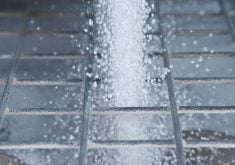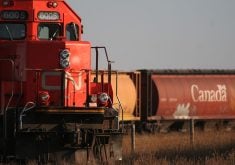This story is part two of a pair of stories looking at sprayer speed. Part one appeared in the April 30 edition and is available on our website.
Speed spraying at 20 miles per hour is no longer the exception. It’s the new norm made possible by new suspensions.
Previous generations of sprayers were buckboard rough, with nothing but a bad ride for operators who dared to venture past the recommended 10 to 12 m.p.h. range. Running at higher speeds causes back problems for drivers, extra trips to the welding shop, early boom replacements and sub-standard spray jobs.
Read Also

Trump’s tariffs take their toll on U.S. producers
U.S. farmers say Trump’s tariffs have been devastating for growers in that country.
While it was generally accepted that 20 m.p.h. wasn’t the best thing for a high yield, that speed remained the Holy Grail of applicators. With better suspensions, sprayer speeds crept up toward that magical mark. Owners and operators were generally happy. However, it became apparent that higher speeds created a new problem in the form of synthetic air turbulence.
This is manmade turbulence caused by moving a big object through the air. It wreaks havoc with spray patterns and caused spray drift, according to Gary Moffat, owner of Specialized Spray Systems in Lethbridge.
Moffat is in the business of modifying and tuning sprayers so they can run at 20 m.p.h. without spray drift problems and without poor deposition problems farmers have come to accept with higher speeds. He feels properly set up booms can also put 15 to 25 percent more droplets on target and eliminate the fine droplets that blow away.
“What we do is get rid of that turbulence. We’ve got to put those nozzles down in free air so the droplets being produced can be taken down to the target by gravity,” says Moffat, adding that he lowers the nozzles and angles them back slightly to reduce wind shear.
“We’re able to see on our Droplet Scan water sensitive cards that we produce a uniform droplet spectrum and uniform droplet pattern across the boom, left to right.”
It’s generally accepted that operators who spray at 20 mph know they cannot put the boom down to 20 inches for a quality spray job, even with automated boom height technology. At high speed, boom bounce dictates a higher boom ride and that automatically results in poor product deposition.
“That’s wrong,” says Moffat. “Where all that 20 inch boom height business came from was back when we were testing 110 degree flat fan nozzles and getting triple overlap. We thought the triple overlap, or the angle water comes out the nozzle, keeps going. Well it doesn’t. It only extends to 20 inches max.
“If you raise that boom up to what we recommend now, at least 30 inches and up to 36 inches, we’ll test the spray pattern and it’ll be flat right across. The water spins back and overlaps so it gives us a very even pattern.”
Moffat says those results are with Air Bubble Jet nozzles. He explains that he sells Air Bubble Jet because they give the most uniform droplet spectrum, giving the most coverage from each tip.
Moffat says all above information is for naught if producers don’t give the boom a proper tune up.
While he says he won’t give away his trade secrets, he is willing to share basic information.
All boom sections must get the exact same liquid volume.
In the turbulent tire areas and tractor areas, relocate nozzles back and down.
On the boom, lower nozzles so the end of the nozzle is at least 0.5 inch below the boom and angled back slightly.
Moffat charges producers for his services, both at the shop and on the farm. However increased efficiency for a sprayer that might cover 3,000 acres and more, several times each year can have a rapid payback. After modifications, and sometimes before he performs Droplet Scans, they are about $450. It can show off a sprayers foibles.
Once a boom has been tuned it should be good for the life of the machine, or until somebody messes with it, he says. New booms direct from the factory are often out by 25 percent and sometimes as much as 40 percent, so investing in a Droplet Scan test might be a good idea, says the sprayer specialist.
Moffat emphasizes that water sensitive paper is essential in all boom and nozzle tuning activities. Eyeballing droplets on paper puts you in the ballpark, but the Droplet Scan is necessary if you want precise tuning data. Although it would be a handy tool for all serious applicators, the $10,000 purchase price puts it out of reach for most people.
“There are only about 20 Droplet Scans in all of Canada, the States and Australia. I’m one of the very few individuals to own their own Droplet Scan. It’s a powerful tool that gives me information I could not obtain by any other method.”
Moffat has spent his career dealing with nozzles, spray patterns, turbulence and spray drift. He suggests that producers think carefully about wind flow blocking devices when adding them to their sprayers as those can potentially add disturbance that negatively affects coverage.
For more information about Moffat’s techniques he can be reached at 403-330-9085.















